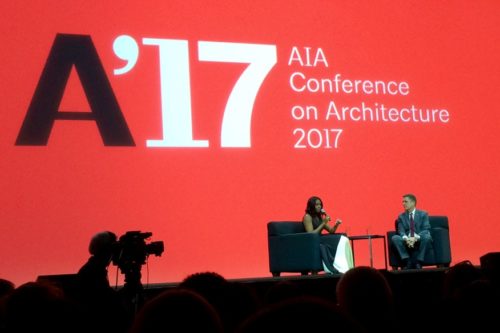Most of you have heard of her. You may know her as a former first lady or as an advocate for educating girls around the world. In her first public appearance since returning to civilian life, Michelle Obama joined AIA President Tom Vonier at the AIA Conference on Architecture 2017 for a candid conversation.
In the days leading up to her keynote address, the excitement was palpable. Everyone I spoke with at the conference couldn’t wait to see her. Two hours before her talk, hundreds of people were already lined up to get a seat. I was one of more than 5,500 architects who turned out to listen!
Michelle talked about working to provide a promising future to the next generation, gender equality in the workplace, why architecture matters, and she shared a little bit about life after the White House.
I left her talk feeling inspired and empowered for what the future may hold, and I’ll share a few of her thoughts with you.
The next generation
Michelle discussed the work that needs to be done to support the next generation. She said we need to invest in children by providing education, healthy food options and food education, and by teaching them life skills.
She said many children in this country seem to fall into a gap where they are not provided access to education or grow up in households were no one works. They miss out on learning valuable skills.
Tom asked specifically about how she thought creating diversity in the work place could be achieved.
Michelle responded, “The struggle is still real. You can’t start recruiting from a pool that doesn’t exist.” The only way to create diversity in the work place and professional workforce is to build the pool. This work must start with kids that are young, and they must be taught what their options are early.
Michelle started the Let Girls Learn initiative while she was the first lady, and it is part of her effort to educate young girls about everything they can be. It’s her passion.
Michelle said, “Education, to my mind, is key to giving women the voice, the structure, the strategy, the tools to improve their conditions. Because if you change the life of a woman, you change the life of a community, a family, a nation.”
Gender equality in the workplace
Michelle talked about empowering women in the workplace. This was a great reminder that while it can seem impossible to have children and a career, it’s not. Women have the ability to work, be parents, and manage a family.
She spoke from personal experience and told her story about considering leaving work after having children. She had made up her mind that she was going to quit working, and her employer asked for an opportunity to meet before she made a decision.
She decided to be very candid about what she would need. She brought her baby and left her with the receptionist. In the meeting, she asked for what she needed: more money than she thought they would give her and more flexible hours to accommodate daycare and errands.
She was very surprised to find that her demands were not unreasonable. They valued her and gave her what she asked for to make motherhood and work fit together.
She realized that she would have to accept the offer, and that this was progress for not just her but for women. The key is being open with your employer and making your needs clear.
Michelle said: “If you have leverage, you have to push for the women who don’t. We have to start asking for what we need, and then we need employers to be more open to what work-life balance can actually look like.”
Tom asked what the quest for a better work-life balance from the female perspective has meant to her.
Michelle said: “It’s not easy, and it’s never going to be. The one thing I can say to working mothers out there: Don’t beat up on yourselves. What you are doing is hard, and we still don’t live in a society that supports it.”
Why architecture matters
After Tom directed the conversation toward architecture, Michelle reflected on what it means to her.
Architecture provides the formwork to create a sense of community through shared public space, Michelle said. It serves as a platform for bringing people together. Parks, districts, communities and homes are what make a neighborhood beautiful for a family or for a child who feels like no one cares. Buildings are a part of the lifeblood of a community, and it is important that they are thoughtful and responsive to the needs of the people that use them.
Michelle praised the efforts of Todd Williams Billie Tsien Architects on the design of the Obama Presidential Library.
She said: “I don’t get to work with architects often, but ours are so much fun. The creative process, space and time, they think about things that we wouldn’t ever think of. We’re also closely considering the exterior, and how it will relate to the community. The architects we’re working with are phenomenal; they’re listening, they’re doing their homework, they’re researching and starting to understand the South Side of Chicago.”
She reminded the crowd, that at one time, Barack Obama wanted to be an architect.
“Barack is an artist, though he tries to downplay it,” she said. “He’s the kind of guy who says, ‘I don’t care what the living room looks like,’ and then has a thousand questions and opinions about everything. He’s someone with ideas, he’s someone who thinks big. That’s what architects do too, right?”
Her response was endearing and a reminder of why our work is important. A new home that is full of light and provides open family living or a new community center for gatherings can provide a new sense of pride to a family or community who needs it most.
Life after the White House
On this final topic, Michelle said one of the hardest things about leaving was missing the White House staff, who turned into her family.
She followed that by saying the transition has been nice for her daughters. They can actually open their windows now or go outside. Michelle can also personally answer the door when her friends come by, which still takes visitors by surprise.
To end their talk, Tom asked the question on everyone’s mind: “Is there a chance that you would run for public office in the future?” The answer was quick: “No.”
Michelle said her primary reason was her children.
“It’s all well and good until you start running, and then the knives come out. Politics are tough, and it’s hard on a family,“ she said. “I wouldn’t ask my children to do this again because when you run for higher office, it’s not just you; it’s your whole family. There’s just so much more we can do outside of the office because we won’t have the burden of political baggage.”
Michelle has big ideas for the positive work the future holds for her and former President Obama. Her optimism for what seems possible could be felt throughout the room. It was a wonderful experience to hear her speak. Thank you, AIA!


